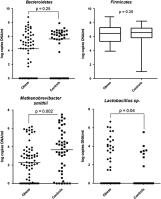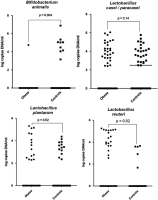Obesity-associated gut microbiota is enriched in Lactobacillus reuteri and depleted in Bifidobacterium animalis and Methanobrevibacter smithii
- PMID: 21829158
- PMCID: PMC3374072
- DOI: 10.1038/ijo.2011.153
Obesity-associated gut microbiota is enriched in Lactobacillus reuteri and depleted in Bifidobacterium animalis and Methanobrevibacter smithii
Retraction in
-
Retraction Note: Obesity-associated gut microbiota is enriched in Lactobacillus reuteri and depleted in Bifidobacterium animalis and Methanobrevibacter smithii.Int J Obes (Lond). 2024 Oct;48(10):1516. doi: 10.1038/s41366-024-01595-3. Int J Obes (Lond). 2024. PMID: 39075172 No abstract available.
Abstract
Background: Obesity is associated with increased health risk and has been associated with alterations in bacterial gut microbiota, with mainly a reduction in Bacteroidetes, but few data exist at the genus and species level. It has been reported that the Lactobacillus and Bifidobacterium genus representatives may have a critical role in weight regulation as an anti-obesity effect in experimental models and humans, or as a growth-promoter effect in agriculture depending on the strains.
Objectives and methods: To confirm reported gut alterations and test whether Lactobacillus or Bifidobacterium species found in the human gut are associated with obesity or lean status, we analyzed the stools of 68 obese and 47 controls targeting Firmicutes, Bacteroidetes, Methanobrevibacter smithii, Lactococcus lactis, Bifidobacterium animalis and seven species of Lactobacillus by quantitative PCR (qPCR) and culture on a Lactobacillus-selective medium.
Findings: In qPCR, B. animalis (odds ratio (OR)=0.63; 95% confidence interval (CI) 0.39-1.01; P=0.056) and M. smithii (OR=0.76; 95% CI 0.59-0.97; P=0.03) were associated with normal weight whereas Lactobacillus reuteri (OR=1.79; 95% CI 1.03-3.10; P=0.04) was associated with obesity.
Conclusion: The gut microbiota associated with human obesity is depleted in M. smithii. Some Bifidobacterium or Lactobacillus species were associated with normal weight (B. animalis) while others (L. reuteri) were associated with obesity. Therefore, gut microbiota composition at the species level is related to body weight and obesity, which might be of relevance for further studies and the management of obesity. These results must be considered cautiously because it is the first study to date that links specific species of Lactobacillus with obesity in humans.
Figures



Similar articles
-
Correlation between body mass index and gut concentrations of Lactobacillus reuteri, Bifidobacterium animalis, Methanobrevibacter smithii and Escherichia coli.Int J Obes (Lond). 2013 Nov;37(11):1460-6. doi: 10.1038/ijo.2013.20. Epub 2013 Mar 5. Int J Obes (Lond). 2013. Retraction in: Int J Obes (Lond). 2024 Sep;48(9):1356. doi: 10.1038/s41366-024-01557-9. PMID: 23459324 Free PMC article. Retracted.
-
Lactobacillus reuteri and Escherichia coli in the human gut microbiota may predict weight gain associated with vancomycin treatment.Nutr Diabetes. 2013 Sep 9;3(9):e87. doi: 10.1038/nutd.2013.28. Nutr Diabetes. 2013. PMID: 24018615 Free PMC article.
-
Retraction Note: Obesity-associated gut microbiota is enriched in Lactobacillus reuteri and depleted in Bifidobacterium animalis and Methanobrevibacter smithii.Int J Obes (Lond). 2024 Oct;48(10):1516. doi: 10.1038/s41366-024-01595-3. Int J Obes (Lond). 2024. PMID: 39075172 No abstract available.
-
Profile of the gut microbiota of adults with obesity: a systematic review.Eur J Clin Nutr. 2020 Sep;74(9):1251-1262. doi: 10.1038/s41430-020-0607-6. Epub 2020 Mar 30. Eur J Clin Nutr. 2020. PMID: 32231226 Review.
-
The development of probiotic treatment in obesity: a review.Benef Microbes. 2014 Mar;5(1):19-28. doi: 10.3920/BM2012.0069. Benef Microbes. 2014. PMID: 23886977 Review.
Cited by
-
The Influence of Probiotic Supplementation on the Obesity Indexes, Neuroinflammatory and Oxidative Stress Markers, Gut Microbial Diversity, and Working Memory in Obese Thai Children.Foods. 2023 Oct 24;12(21):3890. doi: 10.3390/foods12213890. Foods. 2023. PMID: 37959009 Free PMC article.
-
Molecular Mechanisms behind Obesity and Their Potential Exploitation in Current and Future Therapy.Int J Mol Sci. 2024 Jul 27;25(15):8202. doi: 10.3390/ijms25158202. Int J Mol Sci. 2024. PMID: 39125772 Free PMC article. Review.
-
Clinical evidence of the role of Methanobrevibacter smithii in severe acute malnutrition.Sci Rep. 2021 Mar 8;11(1):5426. doi: 10.1038/s41598-021-84641-8. Sci Rep. 2021. PMID: 33686095 Free PMC article. Clinical Trial.
-
Ruminal microbiota and muscle metabolome characteristics of Tibetan plateau yaks fed different dietary protein levels.Front Microbiol. 2024 Feb 14;15:1275865. doi: 10.3389/fmicb.2024.1275865. eCollection 2024. Front Microbiol. 2024. PMID: 38419639 Free PMC article.
-
Nonalcoholic fatty liver disease and the gut microbiome: Are bacteria responsible for fatty liver?Exp Biol Med (Maywood). 2019 Apr;244(6):408-418. doi: 10.1177/1535370219836739. Epub 2019 Mar 14. Exp Biol Med (Maywood). 2019. PMID: 30871368 Free PMC article. Review.
References
-
- Appropriate body-mass index for Asian populations and its implications for policy and intervention strategies. Lancet. 2004;363:157–163. - PubMed
-
- Yanovski SZ, Yanovski JA. Obesity. N Engl J Med. 2002;346:591–602. - PubMed
-
- Lawlor DA, Smith GD, O'Callaghan M, Alati R, Mamun AA, Williams GM, et al. Epidemiologic evidence for the fetal overnutrition hypothesis: findings from the mater-university study of pregnancy and its outcomes. Am J Epidemiol. 2007;165:418–424. - PubMed
-
- World health organization Obesity and overweightFact sheet N°311.2011
Publication types
MeSH terms
LinkOut - more resources
Full Text Sources
Other Literature Sources
Medical

